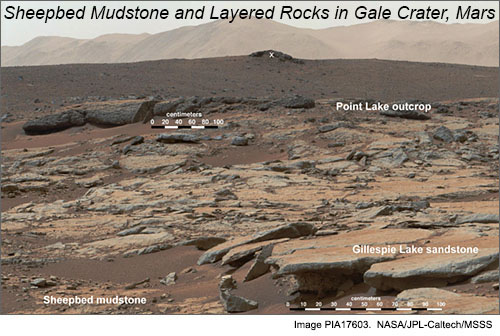Quick Views of Big Advances
The First Rock Ages Returned from the Surface of Mars
For the first time in the history of space exploration, we have ages of rocks on the surface of Mars thanks to scientists associated with NASA's Mars Science Laboratory mission and data collected by Curiosity rover at Gale crater.The amazing part of age dating using the instruments on the Curiosity rover is that it has never been done anywhere but on Earth due to the sophisticated equipment required to measure the amount of argon in a rock sample. So, prior to the mission's launch on November 26, 2011 NASA put out a call for new and exciting experiments that could be run simultaneously with Curiosity's prearranged experiments. Farley and his team answered that call by proposing the rover carry equipment similar to what we use to date rocks in Earth-bound laboratories.
The team measured the potassium concentration in the rock powder using the APXS, and then Curiosity's on-board equipment took the rock powder, heated it to temperatures high enough for the argon to escape and then let the mass spectrometer on the SAM instrument do the heavy lifting. The team found that the mudstone has a Noachian to early-Hesperian age, 4.21 ± 0.35 billion years old. This result was not completely unexpected. Using crater-counting techniques (based on older surfaces having more impact craters than younger surfaces) performed long before MSL launched, researchers predicted an age of 3.6–4.1 billion years for the surface. (See image below.)
 |
Location of mudstone sample dated by the potassium-argon dating technique onboard the Curiosity rover. This image combines elevation data from the High Resolution Stereo Camera on the European Space Agency's Mars Express orbiter, image data from NASA's Mars Reconnaissance Orbiter Context Camera, and color information from Viking Orbiter imagery. From NASA/JPL-Caltech. Click for more information and higher-resolution versions.
Farley and his team also designed experiments to determine how long various rocks have sat on the surface of Gale crater by measuring the isotopes of helium, neon, and argon produced in the rock because of exposure to cosmic rays. This is a common method used on meteorites and Moon rocks, dubbed surface exposure dating. They found the mudstone at Gale crater has been exposed at the surface (most likely by the erosion of overlying rock layers by windblown sand) for close to 80 million years—a short time in Martian history that may have important implications for finding evidence of possible organic materials on Mars. Cosmic rays disintegrate organic matter at the surface, but at a very slow rate, meaning that the relatively short time these mudstones have been exposed could potentially improve the prospect of finding any preserved organic compounds at a future drill site. Considering this exciting news, we can look forward to more exciting discoveries as Curiosity roams Gale crater.
![]() (pdf version)
(pdf version)
See Reference:
· Farley, K. A., Malespin, C., Mahaffy, P., Grotzinger, J. P., Vasconcelos, P. M., Milliken, R. E., Malin, M., Edgett, K. S., Pavlov, A. A., Hurowitz, J. A., Grant, J. A., Miller, H. B., Arvidson, R., Beegle, L., Calef, F., Conrad, P. G., Dietrich, W. E., Eigenbrode, J., Gellert, R., Gupta, S., Hamilton, V., Hassler, D. M., Lewis, K. W., McLennan, S. M. Ming, D., Navarro-González, R., Schwenzer, S. P., Steele, A., Stolper, E. M., Sumner, D. Y., Vaniman, D., Vasavada, A., Williford, K., Wimmer-Schweingruber, R. F., and the MSL Science Team (2013) In Situ Radiometric and Exposure Age Dating of the Martian Surface, Science Express, December, 2013, doi: 10.1126/science.1247166 [abstract].
See also:
· NASA Curiosity: First Mars Age Measurement Press Release from the Jet Propulsion Laboratory.
· Sampling system, including the drill described in detail at the MSL Science Corner.
· Spectrometers, including APXS and SAM on MSL Curiosity Rover.
Written by Jesse Davenport, Centre de Recherches Pétrographiques et Géochimiques,CRPG, Nancy, France, for PSRD.
|
|
[ About PSRD | Archive | CosmoSparks | Search | Subscribe ] [ Glossary | General Resources | Comments | Top of page ] |
|
January 2014
|

